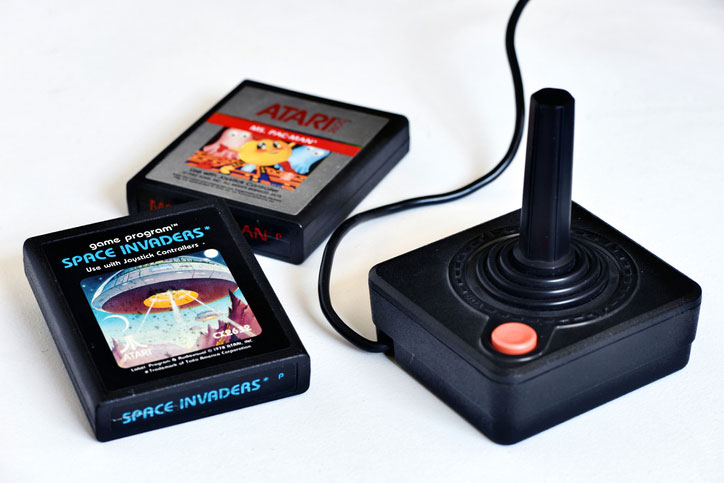Valuable Lessons from Atari on How to Level-Up on Education Post-COVID-19
6/11/2020

"If I was going to school right now to be a teacher," a colleague said during the COVID-19 lockdown, "I'd be thinking about doing something else."
"Why?" I asked.
"Because this isn't teaching," he said with no trace of a smile or humor anywhere on his face, "This is hell."
I'd never heard this teacher speak with such rancor and negativity before. I'd only known him for a few years but he'd been teaching 29 and was deeply respected by all. He was a man of deep and sincere hope and positivity, so his honesty surprised me, and discouraged me. If he's down, I thought, what will everyone else be like?
By the end of the school year, however, he - more than any other teacher or staff in our school - was the source of inspiration and stability. He brought hope to the school and encouragement to the students by embodying what it meant to persevere and endure. He was our anchor, and his name was Kevin Shaw.
With the invasion of COVID-19, our educational worlds were completely disrupted, leaving many of us to throw up our hands while forcing others of us to fall on our knees. It also inspired educators to unite and encourage their schools and communities because that's what great educators do! They take in the bad, acknowledge the damage, then find new and creative ways to teach and inspire and connect with kids. They endure.
Like in the first few days of schools shutting down and social media was crawling with videos and challenges for staff and students to participate in, if only to show our students, our communities, and ourselves that we were still here, that we missed our students, and that as much as possible, we would fight to maintain a positive and purposeful spirit. Educators would not be defeated! And it was truly encouraging to witness. But only for a time.
These moments of energy and exuberance, although catchy and fun and important to the immediate wellbeing of a school and community, can carry with them some unforeseen yet disastrous unintentional consequences. Rather quickly, they can become distractions from learning and improving education rather than traction. They can deter us when they should be refining us.
And that is my fear.
If we're not careful, if we're not intentional with this unique time, several months from now we will head back into our halls and classrooms, rejoice at seeing our students, hug and high five with confidence and thankfulness, then continue teaching and educating in much the same way as we did before the COVID-19 outbreak; in much the same way we have been educating for the past several decades.
While the world around has been rapidly evolving, education has been slowly adapting. We've used catch phrases like "tech integration," "twenty-first century libraries," and "embrace change" as foundations for classroom curriculum, conferences, and professional development days, yet have actually advanced very little. We've read books and lifted up teachers who embody a new way of teaching yet failed to adapt those strategies nationwide. We've listened to countless podcasts or nodded in approval as keynote speakers discuss the changes education must make to best support and love our kids, yet only a handful of schools and teachers have truly made the transition and changed their classrooms to fit such needs.
As a whole, education is behind. COVID-19 has provided us an opportunity to catch up by forcing us to break our educational norms.
We are creatures of habit, and habits are often difficult to break because, as The Onion recently mocked, people will "remain fully committed to things they recognize" and "have seen or experienced previously." Humans tend to stick with what they know. Which is why changing and shifting away from our teaching norms can be so difficult.
What is also true is that, "Human achievement in every field is driven by the desire to explore, to test and prod, to see what happens, to question how things work, and to wonder why and ask, what if?" (Ken Robinson, Creative Schools: The Grassroots Revolution That's Transforming Education).
These notions, although seemingly in contrast to each other, easily coexist within the complicated realm of the human psyche, just as the fictitious Onion article acutely observed,
"when exposed to a particular thing and asked their opinion of it, 100 percent of Americans who recognized the thing said they like it. At the same time, 100 percent of Americans who did not recognize the thing reportedly said they did not like it and found it confusing. However, researchers noted that most of those who were exposed to the novel thing a second or third time changed their mind and said they liked it now" (Nation Reaffirms Commitment To Things They Recognize- bold and italics added).
We stick with what we know because we know it. We're also eager and willing to try new things because we're curious. COVID-19 and the elongated online schooling has allowed us to embrace this conundrum by not only forcing us into new territories of teaching and learning, it has forced us to become comfortable with it - to know it - which means we are more likely to use it.
The danger, however, is that we don't. That we get complacent, distracted, or exhausted rather than inspired. The danger is that we end up like Atari and not like Mr. Shaw.
The History of Atari and the Future of Education: What Educators Can Glean From Atari's Downfall

Before Nintendo, X-Box, and PlayStation, "there was really only one type of video game: arcade games." Then, in the late 1970's Atari introduced Pong and started a revolution.
"Atari took off," Lizzy Peabody, the host of the podcast, The Worst Video Game Ever, states, "They brought the excitement of the arcade into the suburban living room," forever changing the way we interact with our T.V.s, our free time, and each other. And they didn't do it by accident.
In order to change the world, the CEO and creative minds of Atari needed to invent something new and exciting and innovative, while also being familiar. They saw a culture that was enamored with arcade games, sought ways to challenge their current boundaries and norms, then surrounded themselves with "the world's best programmers" who were committed to becoming "geniuses at figuring out how to make games "interesting" and "fun."
Within a few short years, "Atari was the fastest-growing company in the history of the United States, commanding 75% of the home videogame market and bringing in more than $2 billion a year . . . No other company could keep up." So, in 1981, when Atari attempted to conquere Hollywood, no one was surprised.
Howard Scott Warshaw, one of the world's best programmers at the time, "spent eight months working on, ‘Raiders of the Lost Ark: The Video Game." Once released, the "game sold well." So, when Steven Spielberg made another blockbuster hit, ‘E.T. The Extraterrestrial' in the summer of 1982, "it was a no-brainer." They would make a video game of that movie, too.
Only this time, instead of nation-wide success, they would experience complete and devastating failure.
Atari believed "they could do nothing wrong." They were on top of the gaming world and were still riding high from the success of "Raiders of the Lost Ark." And because nothing was broke, nothing needed to be fixed. They just needed to produce another game, much like they had many times before, and the money would flow. It truly was a no-brainer. Which was the exact and perfect reason why it failed.
Howard Scott Warshaw was tasked with creating "E.T. The Video Game" in just five weeks - rather than 8 months - because the game "needed to be in stores by Christmas or they'd lose millions of dollars in potential holiday revenue." Against all odds, Howard came through. "E.T. The Video Game" was completed on time, five million cartridges were stocked and shelved nationwide, and Steven Spielberg was calling Howard a "certifiable genius."
Kids everywhere couldn't wait to play the game.
Within weeks, however, "E.T. The Video Game" became "the worst video game ever" and would plunge Atari out of business. To hide their shame, "Atari buried the unsold game cartridges in the middle of the desert, where they would never, ever be found."
All because of a "no-brainer" decision.
The downfall of Atari should serve as a reminder, a warning even, to educators everywhere as it teaches (or reminds) us of three essential truths: That in order to be and do great things, we must . . .
- Keep the main thing the main thing,
- Innovate, innovate, innovate!
- At all times, "Outwork and outlast."
Allow me to explain.
Keep the Main Thing the Main Thing

One reason Atari failed was because they lost sight of their central purpose. Or, as Simon Sinek would claim in, Start With Why, they forgot their Why - their central purpose - and became distracted by Stephen Spielberg and his prestige to influence their decisions by shifting their focus towards a secondary objective: making money. Consequently, instead of producing another hit video game that would have wowed kids and excited the world, they created a disaster.
It was "hard to figure out where you were supposed to be going," Lizzie Peabody explained, "As you try to navigate the game, you keep falling into these pits that are everywhere . . . and there are random characters trying to get you." No one really knew what to do. More importantly, no one could figure out why it mattered, leaving the gamer disoriented. Which, according to the game's creator Howard Scott Warshaw, made the game "terrible."
A great video game should be frustrating, Warshaw explains, but never disorienting. "Frustration, Warshaw argues, "ultimately creates satisfaction. It's a huge motivator in a good game, to get better, faster, stronger." Disorientation, however, is disheartening causing even the most enthusiastic and dedicated of gamers to throw up their hands, turn off the console, and quit.
Disorientation is discouraging and frantic; frustration is challenging and conquerable.
Classrooms and lesson plans should be frustrating. They should create a sense of satisfaction for the student as they get better, stronger, and faster in their understanding of the content, skill, or task. They should feel a sense of satisfaction. They should never be disoriented.
From my experience, both as a teacher and as an administrator, teachers understand this and strive to live by it. The problem occurs weeks or months into the year when they are suddenly or methodically pulled in various directions with multiple objectives. Be it the need for higher scores, a school leader's school-wide initiative, or an inspiring conference, book, or podcast which has caused us to consider a new idea, educators are pulled in numerous directions all throughout the year. Add in parent complaints and student input and suddenly the Why at the beginning of the year is shot leaving even the best educators nowhere near where they wanted to be at the start of the year. They're on schedule, perhaps, but the product is confusing, disjointed, and nothing like they dreamed.
A clear and distinct Why, however, will help fight against such distractions and allow teachers and educators to teach and discipline with confidence. It will guide them in their interactions with colleagues and students, drive the way they coach and mentor, it will inspire the way they decorate their rooms, integrate technology, interact with parents, and when to use the restroom. It will influence every decision they make!
It's also what brought Mr. Shaw out of the darkness and back into greatness.
The day after schools were shut down, Mr. Shaw was extremely frustrated. "This sucks!" he said in a tone I had never heard before, "This isn't teaching. This is hell." After 29 years of being an educator, this was the worst thing Mr. Shaw had ever experienced, hands down. And he just couldn't handle it. "This is terrible," he said, "the absolute worst." Then, he left my office.
I was extremely concerned. And not only for Mr. Shaw, but for the entire school. If he was this frustrated, what would the rest of the staff be like?
Then, two days later, he was not only back on track, he was - yet again - leading the way. He was creating engaging online lessons that were being shared by his students to their friends all across the state, encouraging teachers and students, and dancing in staff videos. He was doing what great teachers do in the midst of crisis, he was rising to the occasion, inspiring those around him, and doing whatever was needed to love on and support his students. Because that was his Why. And nothing could deter him from it, not matter how frustrating or daunting the task.
Atari lost sight of what made them great, Howard Scott Warshaw got distracted by another man's vision, and now, both are blamed for creating the world's worst video game of all time. Their main thing was no longer the main thing, so they lost everything.
Mr. Shaw held tightly to his Why and inspired a school, community, and surrounding school districts. Mr. Shaw lost nothing. Those around him gained everything.
A Failure to Innovate and Adapt Assures Nothing But Certain Failure

Another reason why Atari failed was because they stopped innovating. By 1983, "programmers had reached the Atari console's limits for memory and graphics" which meant all games started to look the same - "Gamers got bored." So much so that when people returned E.T. the Video Game, they didn't replace it with something else. Instead, they stopped buying Atari games and consoles all together. "The history books call it, ‘The Video Game Crash of 1983,'" Lizzie Peabody explains, "American video game sales dropped by over 90% from 1982 to 1986. No new game systems were introduced, and hardly any new games were created at all."
Then, in the late 80's the "Japanese game companies Nintendo and Sega brought their consoles" and famous characters to the United States. They also brought a newness and a resurgence to the gaming industry. They brought innovation. It "would be nearly two decades before another American-made console would return to the market in any significant way, with Microsoft's Xbox in 2001."
After years of radical success, Atari was out of business because they became complacent and stopped pushing boundaries. They got comfortable.
The same could easily be said about education. Adam Grant, author of Originals: How Non-Conformists Move the World, explains why.
"Although America is a land of individuality and unique self-expression, in search of excellence and in fear of failure, most of us opt to fit in rather than stand out." We conform rather than take risks because it's safe and often times the more secure path to career advancement. Rocking the boat can get us into trouble; stepping out of it can get us hurt. Going with the flow, however, gets us safely tenure and quietly to retirement.
Playing it safe, however, upsets innovation because it emphasizes conformity rather than curiosity.
At the core of what makes us human is our curiosity, our desire to know and understand, and to test boundaries. We want to know we are alive! Deepak Chopra, author of META HUMAN: Unleashing Your Infinite Potential, says it this way: "human history . . . is about testing the next boundary, and then moving beyond it to test a new boundary . . . Only Homo sapiens turn extreme risk-taking into fun."
Could we say the same about our classrooms? Probably not. At least not always, and for various and valid reasons. When it comes to learning, by and large, our educational system has traded in our humanity for conformity. We have, by and large, replaced genuine learning with comatose test scores because they are quantifiable, because they are measurable. And although they are beneficial and should not be completely done away with, they're not personal, they're safe. And education cannot afford to be only and forever safe.
Learning is dangerous and fun and beyond comfort zones. Which means our schools and classrooms should be too. Each and every day, there should be risks, failures, embarrassing moments, personal success stories, and a great deal of growth; there should be frustration. Instead, there is data.
Innovation, creativity and humanity is, as Chopra writes, "essential for solving complex problems - the kinds we often face in a fast-paced {and unknown} world." The kind of world our students are heading into, but not the kind we are always preparing them for.
COVID-19 forced this on everyone as it required us to innovate with how to educate, assess, and connect. It forced us to innovate, whether we liked it or not. And Mr. Shaw did not like it. At least, not in the beginning.
Mr. Shaw doesn't own a cell phone. He doesn't have Facebook and he for sure does not have TikTok. From what I can tell, his only electronic device is the one that sits on his desk in his science room and is primarily used for grading, creating handouts, and projecting important information for his students. After the nationwide shutdown, however, he was required to teach completely online, which meant creating a Google Classroom account and posting videos daily - something even my seasoned teachers were hesitant to do. Yet, within a few short days, Mr. Shaw was leading the way and inspiring teachers to not only make videos, but to have fun with those videos. He had daily challenges of "Find Beaker" and often asked his students to submit comical and creative videos themselves. Mr. Shaw changed the way he taught so he could best reach and teach his students. He innovated. And in doing so, he solved the complex problem of social learning and taught his students and our staff a valuable lesson on what it means to learn and grow and teach. He inspired us all to be better educators, learners, and humans.
Atari became complacent and stopped pushing the next boundary. Consequently, they fell out of existence. Mr. Shaw continued to innovate. He pushed his personal boundaries of knowledge and comfort which allowed him to overcome any and all obstacles.
To be human is to innovate. And in order to innovate, we must take risks and forge new boundaries. Over and over again. Even when, especially when, it isn't comfortable.
Outwork and Outlast the Naysayers

Our final day of the year was bittersweet. It was sweet because we were finally closing the door to this rather turbulent year; it was bitter because several great teachers were leaving us for new adventures. One of them was Kevin Shaw.
As we gathered together, sharing moments and memories, as we held back tears or allowed them to flow freely, Mr. Shaw sat and listened and sometimes chimed in. At the end, as he wiped his eyes with a balled-up napkin, he asked if he could leave us with one piece of advice.
"Since the beginning of my teaching career, I've had one guiding truth that has carried me through the years and I'd like to share it with you all." As he gathered his words, there was a short pause of silence. There was also a sort of communal leaning in. We were all anxious to hear what he had to say.
"Show up each and every day, outwork and outlast the naysayers, work hard." Heads nodded in agreement, in understanding.
"Get to work," he said, raising his hands in an it's-just-that-simple sort of gesture. Then they fell and he scanned the room, the faces, "get to work."
Sometimes education seems to overthink itself. Like it needs to validate itself through complicated schemes or innovative ways of doing simple things when, often times, all that really needs to happen is for people to show up and work hard. They need to care, about their profession and those around them, and they need to work.
Innovation and greatness, it seems, does not need a grand entrance or radical shifts in how we think and do things. It simply requires dedication.
Kevin Ashton, author of How to Fly a Horse: The Secret History of Creation, Invention, and Discovery, says it this way:
Almost nothing we create will be good the first time. It will seldom be bad. It will probably be a dull shade of average. The main virtue of a first sketch is that it breaks the blank page. It is a spark of life in the swamp, beautiful if only because it is a beginning."
Those who are dedicated to improving their craft, themselves, and those around them will continually break the blank of the first page and then continually improve upon it until it is beneficial to themselves and those around them. Because that's what innovation is: gradual steps of improvement that outwork and outlast the naysayers.
For many reasons, COVID-19 was a curse to the ending of the 2020 academic year. But in many more ways, it can be a blessing that endures well beyond. If only we take the time and energy to take risks and continually break the blank page of complacency and "that's the way we've always done it."
Atari became complacent and distracted. Kevin Shaw was frustrated and focused. One of them was lost forever in the desert, the other a source of power and inspiration.
In the years to come, where will we - the educators - be?
Where will you be?
- Five Ways for You and Your School to Thrive in the 2021-22 School Year - August 30, 2021
- We Did the Math on What a Teaching Degree Will Earn You Over the Life of Your Career. Here’s What We Found… - July 14, 2021
- Teaching is Not a Job. It’s a Calling… - January 6, 2021











